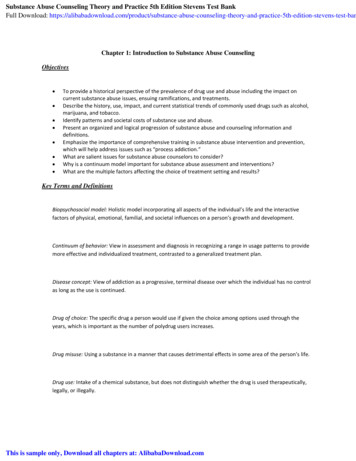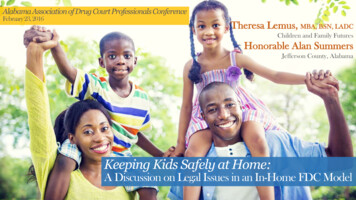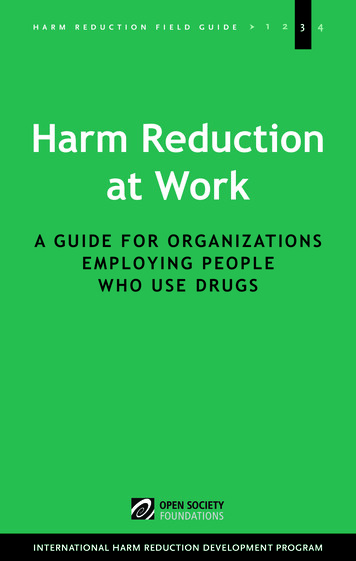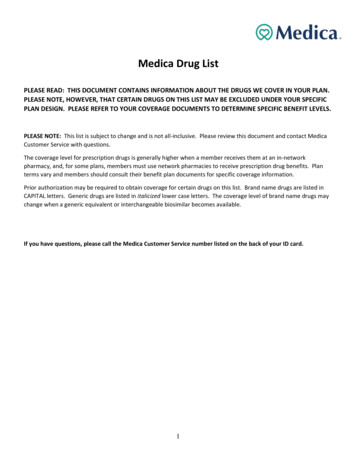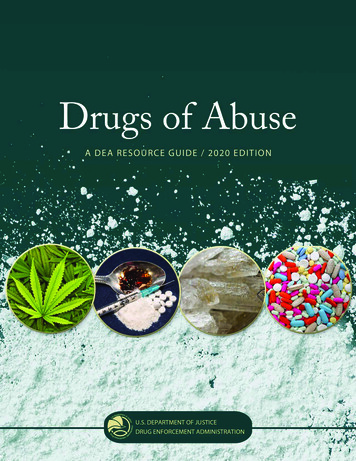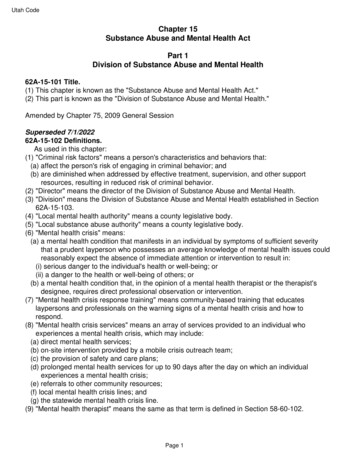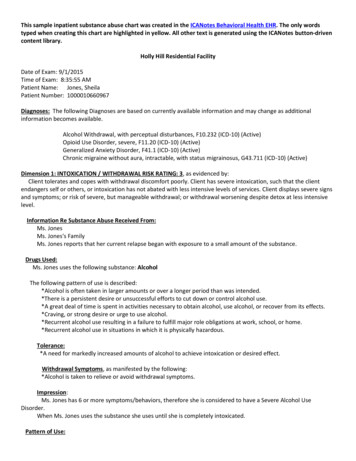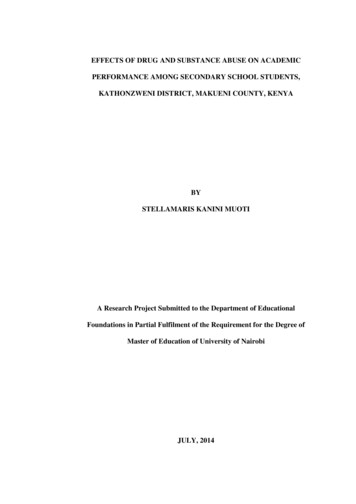
Transcription
EFFECTS OF DRUG AND SUBSTANCE ABUSE ON ACADEMICPERFORMANCE AMONG SECONDARY SCHOOL STUDENTS,KATHONZWENI DISTRICT, MAKUENI COUNTY, KENYABYSTELLAMARIS KANINI MUOTIA Research Project Submitted to the Department of EducationalFoundations in Partial Fulfilment of the Requirement for the Degree ofMaster of Education of University of NairobiJULY, 2014
DECLARATIONThis research project is my original work and has not been presented for a degreein any other University.SignatureDateStellamaris K. MuotiE56/66063/2011This research project has been submitted for approval to my UniversitySupervisor.SignatureDateProfessor Lucy Kibera, Ph.DUniversity of NairobiDepartment of foundations of Educationii
DEDICATIONThis research project is dedicated to my children Caroline Ndanu and NelsonMusyimi. May you have the same urge to further your education to greaterheightsiii
ACKNOWLEDGMENTMy foremost gratitude is to Almighty God that through His amazing grace I wasable to undertake and complete this study. To Him I give honour and glory.I would like to sincerely thank Prof. Lucy Kibera for devoting her time forguidance and recommendations during and especially in the course of thepreliminaries of research proposal. Your patience, dedication and encouragementmade it possible to complete this project.I would like to thank my husband and mentor Charles Musyimi for the moral andmaterial support. I thank my children Caroline and Nelson for the encouragementand understanding during the many hours I left you alone pursuing my furtherstudies. May you have the same urge to further your education to greater heights.I would also like to appreciate my parents Mr. and Mrs. Claude Maundu, mybrothers and my sisters for their encouragement and moral support during thetime of study.I also wish to express my sincere appreciation to school principals and studentswho provided primary data, without which this study would not have beenpossible. I would also like to thank all those who contributed generously, orallyand in documentation; Charles and Rachel Maina. I can’t also forget to appreciateMaingi and Moses for their support during this study.May the Almighty God bless and reward each one of you abundantly.iv
TABLE OF CONTENTSDeclaration . iiDedication . iiiAcknowledgment .ivTable of Contents . vList of Tables . viiiList of Figures .ixList of Abbreviations and Acronyms . xAbstract .xiCHAPTER ONEINTRODUCTION1.1 Background to the Study . 11.1.1 State of Drug and Substance Abuse: Global Perspective . 11.1.2 State of Drug and Substance Abuse in Kenya . 31.1.3 Drug Abuse and Motivation to Learn. 51.2 Statement of the Problem. 71.3 Purpose of the Study . 81.4 Objectives of the Study. 81.5 Research Questions . 81.6 Assumptions of the Study . 91.7 Scope of the Study . 91.8 Limitations of the Study . 91.9 Significance of the Study . 91.10 Operational Definition of Terms . 10v
CHAPTER TWOREVIEW OF RELATED LITERATURE2.1 Introduction. 122.2 Family Background and Drug Abuse . 122.3 Peer Pressure and Drug Abuse . 142.4 Availability and Cost of Drugs and Drug Abuse . 162.5 School Environment and Drug Abuse . 172.6 Socio-Economic Background & Drug Abuse. 192.7 Age and Drug Abuse . 202.8 Drug Abuse and the Category of School . 212.9 Effects of Drug and Substance Abuse on Participation in Learning amongSecondary School Students. 212.10 The Prevalence of Drug and Substance among Secondary School Students232.11 Conceptual Framework . 24CHAPTER THREERESEARCH METHODOLOGY3.1 Introduction. 253.2 Research Design . 253.3 Target Population. 263.4 Sampling Procedures and Sample Size. 263.5 Research Instruments . 273.5.1 Questionnaires . 273.6 Pilot Study . 283.7 Instruments’ Reliability . 283.8 Instruments’ Validity . 29vi
3.9 Data Collection Procedures . 293.10 Data Analysis Techniques . 30CHAPTER FOURDATA ANALYSIS AND INTERPRETATIONS4.1 Introduction . 314.1.1 Response Rate . 314.1.2 Reliability Analysis . 314.2 Demographic Data of Students (Student Characteristics). 324.3 Family Background . 344.4 School Factors . 354.5 Commonly Abused Drugs . 364.6 Causes of Drug Abuse in Schools . 384.7 Prevalence of Drug and Substance Abuse in Schools. 424.8 Effects of Drug Abuse in Schools on participation in learning . 44CHAPTER FIVESUMMARY OF THE FINDINGS, CONCLUSIONS ANDRECOMMENDATIONS5.1 Introduction . 515.2 Summary . 515.3 Conclusions . 535.4 Recommendations . 545.5 Suggestions for Further Research . 55REFERENCES . 56APPENDICES . 60Appendix I: Questionnaire for Students . 60Appendix II: Questionnaire for School Principal . 67vii
LIST OF TABLESTable 4.1: Reliability Coefficients . 32Table 4.2: Age of the Respondents . 33Table 4.3: Gender of the Respondents . 33Table 4.4: Who the Students Live With . 34Table 4.5: Religion of the Respondents . 35Table 4. 6: Category of School . 36Table 4. 7 Frequency of drug abuse in schools . 36Table 4. 8 Frequency of Various Drugs Use in School . 37Table 4. 9 Extent to which various factors influence students to abuse drugs . 38Table 4. 10 Agreement of the students with various statements on drug abuse . 39Table 4. 11: Contribution of various school factors to drug abuse . 40Table 4. 12 Prevalence of Drug and Substance Abuse in Schools . 42Table 4. 13 Records of those students engaged in drug abuse . 43Table 4. 14 Approximate number of students engaged in drug abuse. 43Table 4. 15: Principals reports on Effects of drugs abuse on participation inlearning among students in the schools . 44Table 4. 16 Effects of drug abuse experienced by the students . 45Table 4.17 Attendance of guidance and counselling against drugs by students . 47Table 4. 18 Expected school academic performance by principals in nationalexams . 47Table 4.19: Grade expected by students at KCSE . 48Table 4. 20: Level of education aspired by the students. 49viii
LIST OF FIGURESFigure 1 Conceptual framework.24ix
LIST OF ABBREVIATIONS AND ACRONYMSASALArid and Semi Arid LocationD.E.ODistrict Education OfficerE.F.AEducation For AllM.O.EMinistry of EducationMDGsMillennium Development GoalsNACADANational Agency For the Campaigns Against Drug AbuseSCADStudent Campaign Against DrugsUNUnited Nationsx
ABSTRACTDrug and substance abuse threatens and tends to derail these noble strides bydemotivating the students in learning and subsequently ruining school goingchildren that the government intends to rely on in driving the economy to the nextlevel. Despite the overwhelming intervention strategies by the Government,religious organizations, non-state actors and many other keen stakeholders tocurb the problem of drug and substance abuse especially among the youth, thenumber of school going youth being suck into drug abuse seems to be escalatingday by day. The purpose of this study was to assess the effect of drug andsubstance abuse on participation in learning among secondary school students inKathonzweni District, Makueni County in Kenya. The study used descriptivesurvey design combining both qualitative and quantitative research strategies.The research targeted all the form three students and their respective schoolprincipals in the 31 secondary schools in Kathonzweni District. Nine schoolsconstituting 30% of the 31 schools in Kathonzweni District were sampled.Purposive sampling was used in the selection of the nine schools and theirrespective principals. From each selected school, 20 Form three students wereselected using systematic sampling. Questionnaires were used for data collection.Once data was obtained from the field it was coded and analysed by computerusing a statistical software SPSS (Statistical Package for Social Sciences). Onbasis of the findings, the study concludes that all the principals had experiencedcases of drug abuse by students in their schools. Majority of the principals(87.5%) kept records of those students engaging in drug abuse. The studyconcluded that most of the schools offered guidance and counselling to thestudents and that most of the students had attended guidance and counsellingagainst drugs in their schools. Alcohol was the frequently abused drug in theschools as expressed with a mean of 2.632. The study concluded that drug abuseamong the students caused dropping out of school, strained relationship withother students, lack of interest in studying, low concentration span and declininggrades. The study concluded that anxiety, headache, feeling sleepy, confusionand vomiting were serious effects of drug abuse among students and that thestudents have friends who take drugs. The study recommends that all schoolsshould set up guidance and counselling offices facilitated by professionals tocounsel students who indulge in drug abuse. Parents and teachers shoulddiscourage students and be firm in ensuring that the students do not take alcoholwhich is the most abused in the schools. The parents should also ensure they donot give so much money to their children and if they do so they should ensurethat the money is put into constructive use.xi
CHAPTER ONEINTRODUCTION1.1 Background to the StudyThe history of human race has also been the history of drug abuse (Maithya,2009). In itself, the use of drugs does not constitute an evil; in fact some drugshave been a medical blessing. (Maithya, 2009) Since, time in memorial earliesttimes, herbs, roots, bark leaves have been used to relieve pain and help controldiseases. History tells us that the Chinese used Opium as a cure of dysenterybefore the 18thcentury. European countries such as Britain and Holland wereknown to exchange opium growth in their colonies for tea and silk with China(United Nations, 1995). Unfortunately, certain drugs that initially produceenticing effects, such as sense of feeling good, elation, serenity and power haveevolved into a problem of dependence and abuse.1.1.1 State of Drug and Substance Abuse: Global PerspectiveDrug abuse is a global problem that poses a great danger to the lives ofindividuals, society and political stability and security in many countries (UnitedNations, 1998). According to the United Nations (2005), the use of illicit drugshas increased throughout the world and the major world trend is the increasingavailability of many kinds of drugs among ever widening spectrum of consumers.Of major concern is that children seem to be targeted as the new market for thedrug industry globally.Drugs and substance abuse has become the focus of research and preventiveactivities in the developed countries for decades (Muyabo, 1996). A study carried1
out by the London School of Economics in 1980 on students learning behaviourrevealed a relationship between drug abuse and poor academic results (Otieno,Balswick & Norland, 1994).Africa has not been spared from the abuse of drugsby the youth. The continent, over recent years has experienced an upsurge in theproduction, distribution and consumption of drugs with the youth and youngadults being most affected (Asuni & Pela, 1986).Africa has huge young and vulnerable populations which has become the targetmarket for the illicit drug industry. This constitutes 56% of the population agedbetween 14-19 years, which constitutes secondary school students. In Ethiopia itis reported that 82 per cent of the street children in Addis Ababa use some kind ofa drug (United Nations, 2013). Besides, the threat of increasing consumption ofillicit drugs amongst the young people and children, South Africa is becoming amajor transhipment point in the international drug trade as well as a majorproducer of Dagaa (Honwana & Lamb, 1998). Gilberto Gerra (2013), the chief ofdrug and preventive health branch at the United Nations office on drugs and crimepointed out that West Africa is completely weak in terms of boarder control,undermanned ports and the big drug cartels from Colombia and Latin Americahave chosen Africa as a way to reach Europe. The United Nations official (Gerra)added that when a country becomes a transit point it immediately becomes aconsumption country.According to the United Nations (UN) statistics 2013, 37,000 people in Africa dieannually from diseases associated with drug abuse. The UN estimates that there28 million drug users in Africa (United Nations, 2013). An Internationalconference on drug abuse in Kampala 2013 reported that young people in2
consumption countries were the most vulnerable section of the population,especially those in the period of early and late adolescence who are mostly unableto resist peer pressure and start experimenting with drugs in schools or evenoutside school. The international conference on drug abuse in Kampala (2013)advocated for an immediate strong inventions to reverse the trend.1.1.2 State of Drug and Substance Abuse in KenyaIn Kenya, reports of young peoples’ lives ruined by alcohol and drugs arerampant. The youth, especially, are vulnerableto the vice owing to peerpressure, media influence, poor guidance and role modelling (Kikuvi, 2009). Thishas taken root in schools leading to the high school drop outs and idleness.According to Amayo and Wangai (1994), drug consumption has led to unrest andwidespread destruction of life and property in schools. Kenya was ranked amongthe top four African Nations notorious for consumption of narcotics by the UnitedNations International Drug Control Programme (World report, 2005).The Kenyan airport of Mombasa has been identified in the report as the majortransit point for drug trafficking in Africa. According to a National survey on themagnitude of alcohol and drug abuse conducted by National Campaign AgainstDrug Abuse (NACADA) (2012), the abuse of alcohol in the country is worrying.The facts and figuresfrom this report indicate that 13 per cent of teenagers inthe 10 to 11 years age bracket have used an intoxicating substance mostly alcoholfollowed by cigarettes. In the 15 to 24 year bracket, a worrying 11.7 per cent arecurrently hooked in to alcohol, while 6.2 per cent are regular users of Tobaccoproducts, of this group, 4.7 per cent chew miraa (khat) while 1.5 per cent smokes3
bhang. Regrettably this age bracket constitutes secondary school going-age inKenya. The sad reality presented by the figures and facts in NACADA’S 2012survey on drugs that is 14.8 per cent of the respondents aged between10 to 14years old are completely oblivious of the risks associated with substance abuse.These statistics underline the need to educate our young people on dangers ofalcohol and drug abuse. A number of studies have found a clear and consistentassociation between substance abuse and school achievement. This practice is notonly a determinant to school success and motivation in learning but also onpsychological and physical well-being among adolescents (Abot, 2005). Theinitiation into substance abuse in the early stages of life of the adolescents ispositively associated to increased risk of early school dropout and an involvementin deviant adolescent behaviours and behavioural problems into adulthood, whichare manifestation in learning among secondary school students (Abot, 2005).If left unaddressed, escalating rate of drug and substance abuse puts the country ata risk of losing generations as well as underdevelopment owing to the diversion ofresources to address among others; basic needs for uneducated and unskilledyouth, dependant young adults, increased health care needs among the youthabusing alcohol and drugs, the cost of policing will also be high due to crimesresulting from idleness and youth drinking habits, all those compounded will go along way in frustrating the attainment of the Millennium Development Goals(MDGs) specifically the Education for All (E.F.A) goal, and the vision 2030which envisages making Kenya industrial and mid-level income country.4
1.1.3 Drug Abuse and Motivation to LearnMotivation is something that energizes, directs and sustains behaviour; it getsstudents moving and points then in a particular direction (Beighler, et al, 1993).Students’ motivation is reflected in personal investment and in cognitive,emotional and behavioural engagement in school activities (Fredrick et al., 2010).Virtually all students are motivated in one way or another. One student may bekeenly interested in classroom subject matter and seek out challenging coursework, participate actively in class discussions and earn high marks; anotherstudent may be more concerned with the social side of school, interacting withclassmates frequently, attending extracurricular activities almost every day. Stillanother may be focussed on athletics, excelling in physical education classes.Motivation increases student’s time on task which is an important factor affectingtheir learning achievement (Brophy, 1988) a motivated student makes a concertedeffort to understand classroom material. The more motivated students are, themore they want to be accepted and respected by peers. Students who have littleinterests in academic achievement are at high risk of dropping out before theygraduate from high school. Yet another student perhaps due to undetectedlearning disability or negative peer pressure and consequently indulgence in drugand substance abuse may exhibit withdrawal symptoms, a shy temperament anduncoordinated behaviour. Such a student may be motivated to avoid academics,social situations or athletic activities, pursue school tasks apathetically with anultimate result of declining performing in academics. According to Ryan et al(2011) indicators of motivation in participation in school related activities includeamong of time spent on homework, rate of homework completion achievement of5
high grades, school attendance and perceptions of the connectedness to school,teachers and peers.Kathonzweni district has posted declining results in Kenya National examinationscompared to neighbouring districts in the country among other factors that can beattributed to this trend is the problem of illicit brew. The region being under theArid and Semi-Arid Land (ASAL) classification is devoid of any meaningfuleconomic activity, this situation has forced many households to turn into illicitliquor brewing as a mainstay to earn a livelihood, school going children in thosehouseholds and the neighbourhood get exposed and introduced to drug abuse at avery tender age. In secondary school it is not rare to find students nursinghangovers resulting from drinking sprees the previous night. The most prevalentillicit brew in the region goes by the native name “Kaluvu”.Data available at the District Education office at Kathonzweni District show thatin 2012 alone, 16 students from 5 secondary schools were an agenda fordiscussion in several District Education Board meetings facing eminent expulsion.Again during sports and other out of school activities, it is common to meetstudents taking alcohol or being suspended for having taken drugs. In a recentEducation Day, the District Education Officer urged that liquor licences of thosewho sell beer to students, be cancelled by the relevant authority. It is against thisbackdrop that the current study sets out to study the effects of drug and substanceabuse on participation in learning in Kathonzweni District of Makueni Countywith a view of suggesting intervention measures to salvage the drug abuse menacein our Kenyan Secondary Schools.6
1.2 Statement of the ProblemDespite the overwhelming intervention strategies by the Government, religiousorganizations, non-state actors and many other keen stakeholders to curb theproblem of drug and substance abuse especially among the youth, the number ofschool going youth being suck into drug abuse seems to be escalating day by day.The government for instance has placed education at the centre of the social pillarof vision 2030 that intents to make Kenya a middle level income country. Toshow its commitment it has highly subsidized secondary school education thusboosting access and retention rates in the system, all these intervention strategieshave had huge cost implications on the taxpayer including the opportunity cost.Drug and substance abuse threatens and tends to derail these noble strides bydemotivating the students in learning and subsequently ruining these school goingchildren that the government intends to rely on in driving the economy to the nextlevel. Drugs and substance abuse menace should therefore be given the attentionit deserves if the intentions of this hefty investment in education are to bear fruits.Kathonzweni District like any other region in the country experiences internalinefficiencies in the school system such as declining academic performance;apathy in learning activities and subsequent drop out in schools as demonstratedin the background to the study. The fact that there is no known study in the regionthat has ever sought to address the problem of drug abuse in secondary schoolsforms a justification of the current study that seeks to establish the effects of drugand substance abuse on participation in learning among secondary school studentsin Kathonzweni district, Makueni County, Kenya.7
1.3 Purpose of the StudyThe purpose of this study was to assess the effect of drug and substance abuse onparticipation in learning among secondary school students in KathonzweniDistrict, Makueni County in Kenya.1.4 Objectives of the StudyThe specific objectives of the study sought to:i) Identify the commonly abused drugs in secondary schools in KathonzweniDistrict.ii) establish the causes of drug abuse among secondary school students inKathonzweni Districtiii) Establish the prevalence of drug abuse among secondary school students ofKathonzweni District.iv) Establish the effects of drug abuse on participation in learning among studentsin Kathonzweni District.1.5 Research Questionsi) What are the commonly abused drugs by students in secondary schools inKathonzweni District?ii) What are the causes of drug abuse among secondary school students inKathonzweni District?iii) How prevalent is drug abuse among secondary school students inKathonzweni District?iv) What are the effects of drug abuse on participation in learning amongsecondary school students in Kathonzweni District?8
1.6 Assumptions of the StudyData from students, teacher counsellor and key informants on the cause,prevalence, effects and the commonly abused drugs was accurate.1.7 Scope of the StudyIt was not possible to carry out the study in all the schools in Kathonzweni districtdue to financial constraints, time factor and other logistics. Again, the studytargeted secondary school students and principals and therefore other stakeholderslike parents and community leaders were not involved in the study.1.8 Limitations of the StudyDrug and substance abuse may involve powerful people in the society and as suchrespondents might have being afraid to give information for fear of beingvictimized. School Principals might have withheld information about drug andsubstance abuse amongst their students since this would tarnish the reputation oftheir schools.1.9 Significance of the Studyi) The findings are expected to yield significant empirical data and informationon the effect of drug and substance abuse on participation in learning andschool participation of learners.ii) The findings are expected to help the ministry of education officials inunderstanding the causes of drug abuse amongst secondary school studentshence help them develop intervention strategies.9
iii) The study is likely to add to the body of knowledge in the area of drug andsubstance abuse in Kenyan secondary schools that may be utilized by otherresearchers.1.10 Operational Definition of TermsAddiction- Having a physical and /or psychological dependence on a substance.Drug abuse- Drug abuse is the non- medical use of drugs that destroys health andproductive life of an individual.Drug dependency- A physical and or a psychological need for a mood- alteringsubstance.Drug- Is any substance that, when absorbed in to the body of a living organism,alters normal bodily function.Hypnos datives- These are drugs that depress brain function. They havequietening and tranquilizing and hypnotic (sleep) effects e.g. benzodiazepines.Kuber- Kuber is a substance made from leftovers from cigarettes manufacturingin India. It is packed in colourful sachets. It cont
2.7 Age and Drug Abuse . 20 2.8 Drug Abuse and the Category of School . 21 2.9 Effects of Drug and Substance Abuse on Participation in Learning among Secondary School Students. 21 2.10 The Prevalence of Drug and Substance among Secondary School Students 23 .
